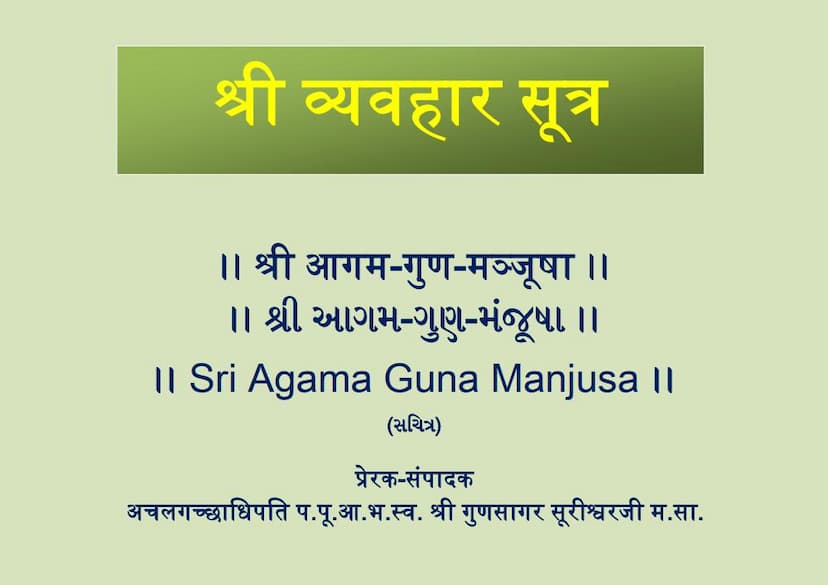Agam 36 Chhed 03 Vyavahara Sutra Shwetambar Agam Guna Manjusha
Added to library: September 1, 2025

Summary
This document is a page from the "Sri Agama Guna Manjusha" (Volume 36, Chhed Sutra 03, Vyavahara Sutra), authored by Gunsagarsuri and published by Jina Goyam Guna Sarvoday Trust, Mumbai. The primary purpose of this excerpt is to provide a brief introduction to the 45 Agamas of Jainism.
The text systematically categorizes and describes these sacred Jain scriptures, which are fundamental to the Shwetambar tradition. The introduction is divided into several sections, each detailing a specific category of Agamas:
I. Eleven Angas (Core Scriptures):
- Acārāṅga-sūtra: Focuses on the conduct of monks and householders, emphasizing the "Charana Karana Anuyoga" (conduct and practice). It has two parts, 25 lessons, and approximately 2500 verses.
- Sūyagaḍānga-sūtra (or Sūtra-Kṛtānga): Known for its discussions on various philosophical views, including ritualists, non-ritualists, agnostics, and restraint-propounders. It primarily deals with the "Dravya Anuyoga" (entity) and has 2000 verses.
- Sthānāṅga-sūtra: Primarily deals with "Ganita Anuyoga" (mathematics) and touches upon other Anuyogas. It is structured around numbers, from one to ten, and contains about 7600 verses.
- Samavāyāṅga-sūtra: A compendium that lists objects from one to crores, also related to "Ganita Anuyoga." It has about 1600 verses.
- Vyakhyā-prajñapti-sūtra (Bhagavati-sūtra): The largest Agama, containing discussions on all four Anuyogas. It is presented in a question-and-answer format between Lord Mahavira and Gautama Ganadhara and has over 15000 verses.
- Jñātādharmakathāṅga-sūtra: Primarily deals with religious narratives and contains 19 stories, totaling 6000 verses.
- Upāsaka-daśāṅga-sūtra: Focuses on the 12 vows of lay followers and the life sketches of 10 great lay disciples, also touching on religious conduct. It has 800 verses.
- Antagaḍa-daśāṅga-sūtra: Contains short life stories of virtuous souls who attained liberation or are on the path to it, primarily religious narratives. It has 800 verses.
- Anuttarovavāyi-daśāṅga-sūtra: Details the life stories of individuals who practiced religious conduct, reached higher realms (Anuttara Vimana), and attained liberation in subsequent lives. It has 200 verses.
- Praśna-vyākaraṇa-sūtra: Primarily deals with "Charana Karana Anuyoga" and describes answers given by the Lord to questions posed by various beings. It has 200 verses and covers aspects of transgression and self-control.
- Vipāka-sūtrāṅga-sūtra: Divided into "Dukkha Vipaka" (fruition of misery) and "Sukha Vipaka" (fruition of happiness), illustrating stories of sinful and virtuous souls respectively. It has 1200 verses.
II. Twelve Upangas (Subordinate Scriptures): The text lists several Upangas, which are considered supportive texts to the Angas. These include:
- Auopapātika-sūtra: A subtext of Ācārāṅga-sūtra, describing Champā city, austerities, and disciples. It has 1500 verses.
- Rājapraśnīya-sūtra: A subtext of Sūyagaḍānga-sūtra, detailing King Pradesi and worship of Jina idols. It has over 2000 verses.
- Jivābhigama-sūtra: A subtext of Sthānāṅga-sūtra, analyzing soul and non-soul, and describing rituals. It has 4700 verses.
- Prajñāpanā-sūtra: A subtext of Samavāyāṅga-sūtra, describing 36 topics and having 8000 verses.
- Sūrya-prajñapti-sūtra & Candra-prajñapti-sūtra: Both deal with astronomy and cosmology ("Ganita Anuyoga"), describing the movements of celestial bodies and time. Each has 2200 verses.
- Jambūdvīpa-prajñapti-sūtra: Another text on "Ganita Anuyoga," detailing the Jambu continent. It has 4500 verses.
- Nirayāvali-sūtra, Kalpāvatamsaka-sūtra, Puṣpika-upāṅga-sūtra, Puṣpacūlikā-sūtra, Vṛṣṇidaśa-sūtra: These are collectively referred to as the "Nirayavali Panchaka" and deal with narratives of kings, princes, and deities, their previous births, and family lineages.
III. Ten Payanna-sūtras (Treatises): These are classified as treatises and include:
- Ātura Pratyākhyāna-sūtra, Bhakta Parijñā-sūtra, Sanstāraka-paryayā-sūtra, Tandula-vicāra-paryayā-sūtra, Chandāvijaya-paryayā-sūtra, Devendra-stuta-paryayā-sūtra, Maraṇa-samādhi-paryayā-sūtra, Mahāpratyākhyāna-paryayā-sūtra, Gaṇividyā-paryayā-sūtra: These cover topics related to final religious practices, death rituals, detachment, astrology, and spiritual conduct. The text mentions that householders can also study these.
IV. Six Cheda-sūtras: These are considered highly advanced texts, studied only by accomplished monks. They are:
- Nishitha-sūtra, Mahānishitha-sūtra, Vyavahara-sūtra, Jita-kalpa-sūtra, Pañca-kalpa-sūtra, Daśa Śruta-skandha-sūtra: These deal with "Utsarga" (general rules), "Apavāda" (exceptions), and "Ālocanā" (confession) and are reserved for monks with profound understanding, compassion, and adherence to Jain principles.
V. Four Mala Sūtras: These are considered foundational and crucial for understanding Jainism:
- Daśavaikālika-sūtra: Described as a "nectar lake" for monks and nuns in the current era. It contains 10 lessons and two Cūlikās. It has 700 verses.
- Uttarādhyayana-sūtra: Contains the final teachings of Lord Mahavira, focusing on detachment and monk's conduct. It has 36 lessons and about 2000 verses.
- Anuyogadvāra-sūtra: Considered the "key to all Agamas," it explains the methods of scripture study and is essential for beginners. It has 2000 verses.
- Āvaśyaka-sūtra: Essential for all four types of Jain followers, it outlines six daily obligatory practices (Samayika, Chaturvimshatistava, Vandan, Pratikramana, Kayotsarga, and Paccakhana).
VI. Two Cūlikās: These are supplementary texts:
- Nandi-sūtra: Contains hymns, analogies for the Jain community, names of Tirthankaras and Gaṇadharas, and descriptions of the five types of knowledge. It has around 700 verses.
- Anuyogadvāra-sūtra: (Also listed as a Mala Sutra) is emphasized as the foundational text for understanding all Agamas, with four types of explanatory devices.
The book aims to provide a structured overview of the vast Jain scriptural tradition, highlighting the importance and content of each category. The provided catalog link further suggests that this is part of a larger collection ("Agama Guna Manjusha") intended for Jain education.